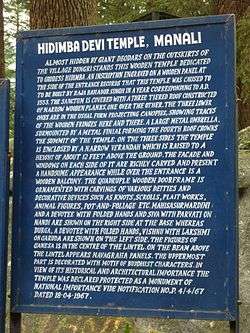Hidimba Devi Temple
| Hidimba Devi Temple | |
|---|---|
 | |
 Hidimba Devi Temple Location in India | |
| Name | |
| Other names | Hadimbi, Dhungari Mata |
| Proper name | Hadimba |
| Geography | |
| Coordinates | 32°14′32″N 77°11′15″E / 32.24228°N 77.187366°ECoordinates: 32°14′32″N 77°11′15″E / 32.24228°N 77.187366°E |
| Country | India |
| State | Himachal Pradesh |
| District | Kullu |
| Culture | |
| Primary deity | Hidimba |
| Important festivals | Dhungari Mela |
Hidimbi Devi Temple, also known variously as the Hadimba Temple, is located in Manāli, a hill station in the State of Himāchal Pradesh in north India. It is an ancient cave temple dedicated to Hidimbi Devi, wife of Bhima, a figure in the Indian epic Mahābhārata. The temple is surrounded by a cedar forest at the foot of the Himālayas. The sanctuary is built over a huge rock jutting out of the ground which was worshiped as an image of the deity. The structure was built in 1553. [1]
History
The Hidimba Devi or Hidimbi Devi temple is built around a cave where Hidimba performed meditation. Hidimba was supposed to have lived there with her brother Hidimb, and not much is known about their parents. Born into a Rakshas family, Hidimba vowed to marry one who would defeat her brother Hidimb, who was supposed to be very brave and fearless. During the Pandava's exile, when they visited Manali; Bhima, one of the five Pandavas, killed Hidimb. Thereafter, Hidimba married Bhima and gave birth to their son Ghatotkacha.
Design
The Hidimba Devi Temple has intricately carved wooden doors and a 24 meters tall wooden "shikhar" or tower above the sanctuary.[2] The tower consists of three square roofs covered with timber tiles and a fourth brass cone-shaped roof at the top. The earth goddess Durga forms the theme of the main door carvings.[3] The temple base is made out of whitewashed, mud-covered stonework. An enormous rock occupies the inside of the temple, only a 7.5 cm (3 inch) tall brass image representing goddess Hidimba Devi. A rope hangs down in front of the rock,and according to a legend,in bygone days religious zealots would tie the hands of "sinners" by the rope and then swing them against the rock.[4]
About seventy metres away from the temple, there is a shrine dedicated to Goddess Hidimba's son, Ghatotkacha, who was born after she married Bhima. The most surprising feature of the temple or what believers could call the most reassuring feature of the temple is the fact that inside the temple the imprint of the feet of the Goddess carved on a block of stone are worshipped and, when zooming into the area where the temple is located via Google Satellite, the imprint of a giant foot spanning across the valley in the area near the temple can be seen.
A Mahabharat narration

The Indian epic Mahabharata narrates that the Pāndavas stayed in Himachal during their exile. In Manali, the strongest person there, named Hidimba and brother of Hidimdi, attacked them, and in the ensuing fight Bhima, strongest amongst the Pandavas, killed him. Bhima and Hidimba's sister, Hidimbi, then got married and had a son, Ghatotkacha, (who later proved to be a great warrior in the war against Kauravas). When Bhima and his brothers returned from exile, Hidimbi did not accompany him, but stayed back and did tapasyā (a combination of meditation, prayer, and penance) so as to eventually attain the status of a goddess.
References
- ↑ "Hidimbi Temple". Retrieved 2006-09-14.
- ↑ "Temples of the Himalayas". Retrieved 2006-09-14.
- ↑ "Hidimba Devi Temple". Retrieved 2006-09-14.
- ↑ "Hidimba Devi Temple". Retrieved 2006-09-14.
External links
| Wikimedia Commons has media related to Hidimba Devi Temple. |
- Oriental Architecture: Hidimdi Devi Temple
- Temples of the Himalayas
- Hidimba Temple
- Distance Between Delhi to Manali